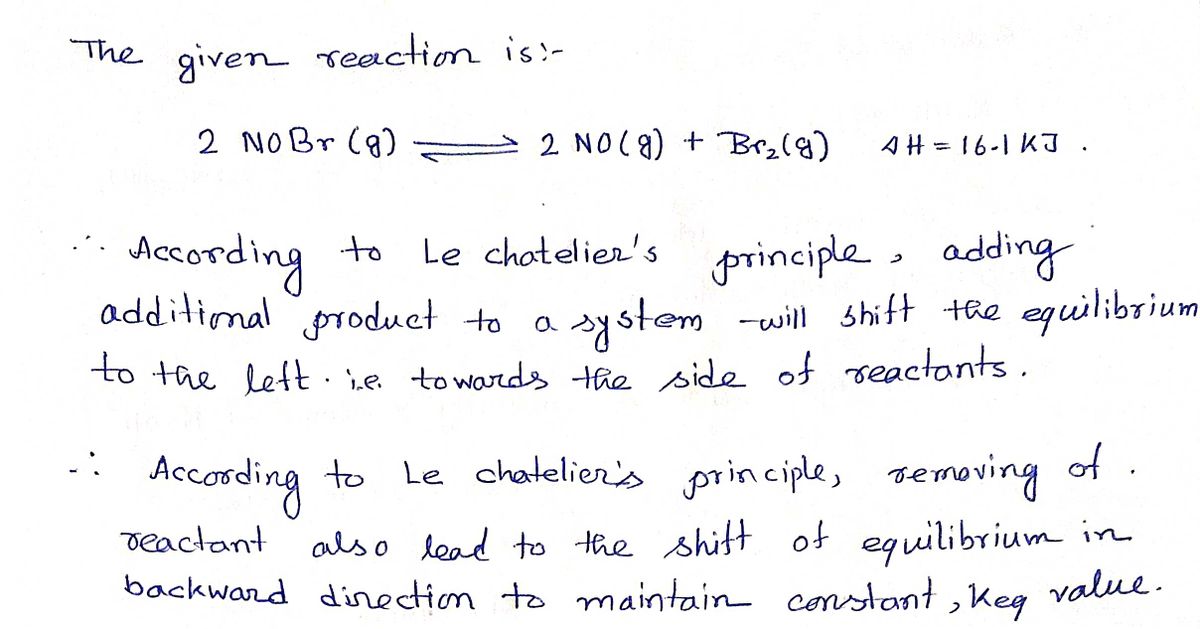2 NOBr(g) 2 NO(g) + Br,(g) AH = 16.1 kJ How does the equilibrium shift after the following stresses? a) Adding more Br, Which way does it proceed? A) Forward B) Reverse C) Neither D) Can't say b) Remove some NOBr Which way does it proceed? A) Forward B) Reverse C) Neither D) Can't say c) Decrease the temperature Which way does it proceed? A) Forward B) Reverse C) Neither D) Can't say What is much different about this third process compared to the first two?
2 NOBr(g) 2 NO(g) + Br,(g) AH = 16.1 kJ How does the equilibrium shift after the following stresses? a) Adding more Br, Which way does it proceed? A) Forward B) Reverse C) Neither D) Can't say b) Remove some NOBr Which way does it proceed? A) Forward B) Reverse C) Neither D) Can't say c) Decrease the temperature Which way does it proceed? A) Forward B) Reverse C) Neither D) Can't say What is much different about this third process compared to the first two?
Chemistry & Chemical Reactivity
10th Edition
ISBN:9781337399074
Author:John C. Kotz, Paul M. Treichel, John Townsend, David Treichel
Publisher:John C. Kotz, Paul M. Treichel, John Townsend, David Treichel
Chapter5: Principles Of Chemical Reactivity: Energy And Chemical Reactions
Section: Chapter Questions
Problem 114SCQ: A piece of gold (10.0 g, CAu = 0.129 J/g K) is heated to 100.0 C. A piece of copper (also 10.0 g,...
Related questions
Question

Transcribed Image Text:2 NOBr(g)
2 NO(g) + Br,(g) AH = 16.1 kJ
How does the equilibrium shift after the following stresses?
a) Adding more Br,
Which way does it proceed?
A) Forward B) Reverse
C) Neither D) Can't say
b) Remove some NOBr
Which way does it proceed?
A) Forward B) Reverse C) Neither D) Can't say
c) Decrease the temperature Which way does it proceed?
A) Forward B) Reverse C) Neither
D) Can't say
What is much different about this third process compared to the first two?
Expert Solution
Step 1

Step by step
Solved in 3 steps with 3 images

Knowledge Booster
Learn more about
Need a deep-dive on the concept behind this application? Look no further. Learn more about this topic, chemistry and related others by exploring similar questions and additional content below.Recommended textbooks for you

Chemistry & Chemical Reactivity
Chemistry
ISBN:
9781337399074
Author:
John C. Kotz, Paul M. Treichel, John Townsend, David Treichel
Publisher:
Cengage Learning

Chemistry & Chemical Reactivity
Chemistry
ISBN:
9781133949640
Author:
John C. Kotz, Paul M. Treichel, John Townsend, David Treichel
Publisher:
Cengage Learning

Chemistry for Engineering Students
Chemistry
ISBN:
9781337398909
Author:
Lawrence S. Brown, Tom Holme
Publisher:
Cengage Learning

Chemistry & Chemical Reactivity
Chemistry
ISBN:
9781337399074
Author:
John C. Kotz, Paul M. Treichel, John Townsend, David Treichel
Publisher:
Cengage Learning

Chemistry & Chemical Reactivity
Chemistry
ISBN:
9781133949640
Author:
John C. Kotz, Paul M. Treichel, John Townsend, David Treichel
Publisher:
Cengage Learning

Chemistry for Engineering Students
Chemistry
ISBN:
9781337398909
Author:
Lawrence S. Brown, Tom Holme
Publisher:
Cengage Learning

Introductory Chemistry: An Active Learning Approa…
Chemistry
ISBN:
9781305079250
Author:
Mark S. Cracolice, Ed Peters
Publisher:
Cengage Learning

Chemistry: An Atoms First Approach
Chemistry
ISBN:
9781305079243
Author:
Steven S. Zumdahl, Susan A. Zumdahl
Publisher:
Cengage Learning

Chemistry
Chemistry
ISBN:
9781305957404
Author:
Steven S. Zumdahl, Susan A. Zumdahl, Donald J. DeCoste
Publisher:
Cengage Learning